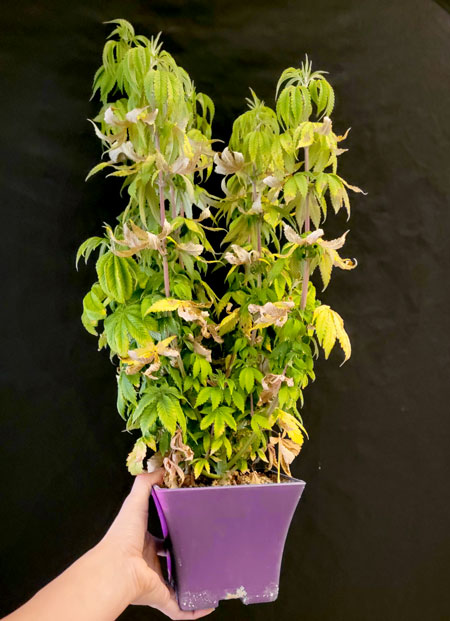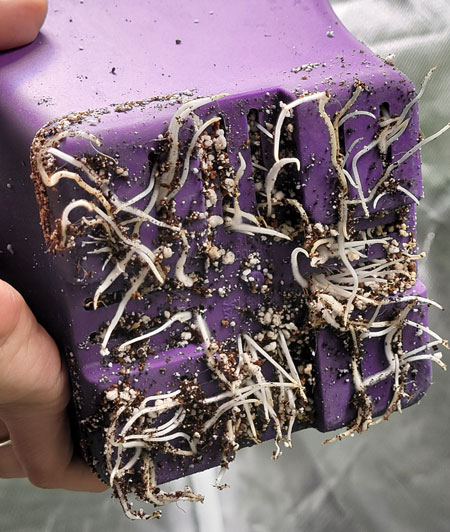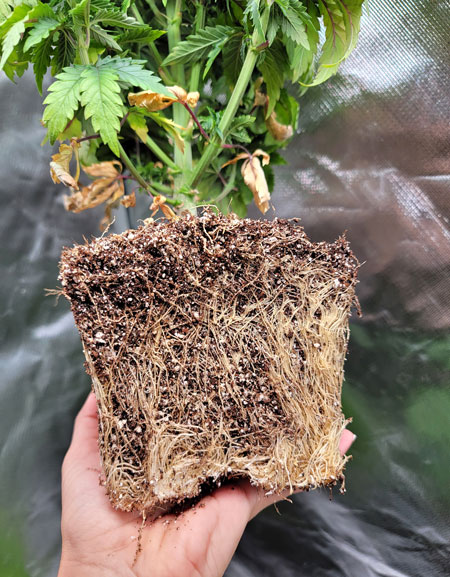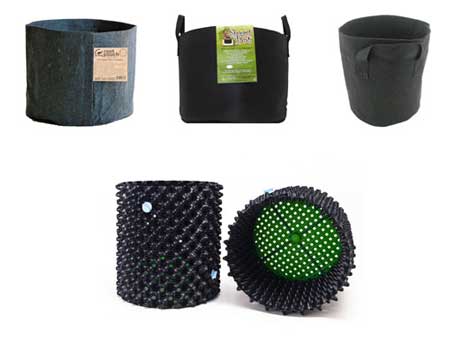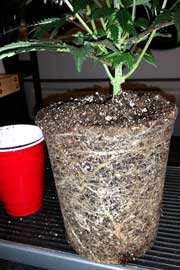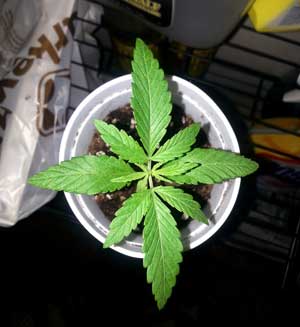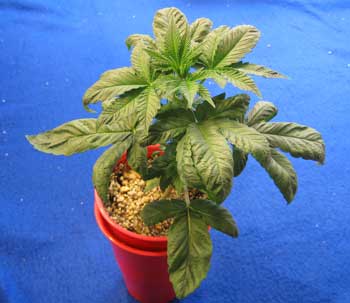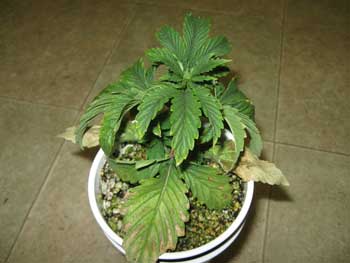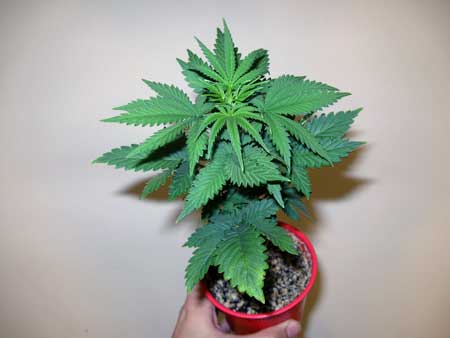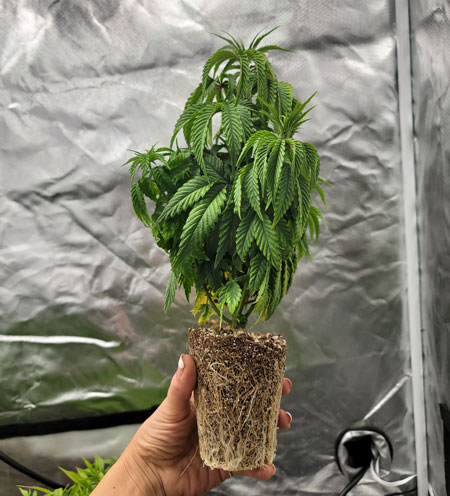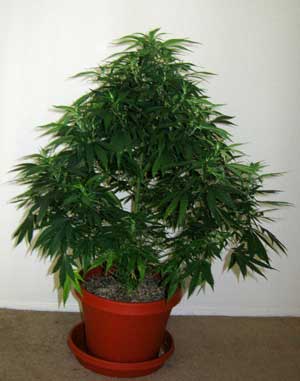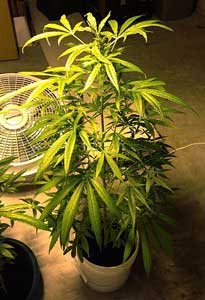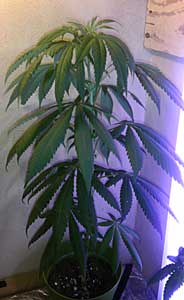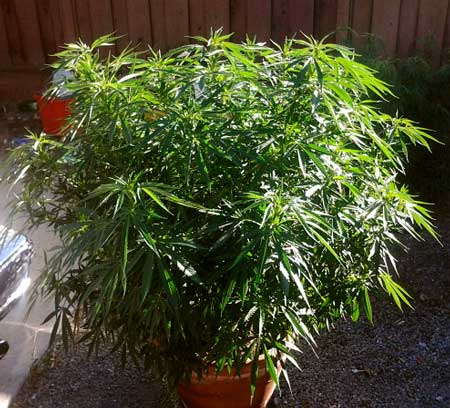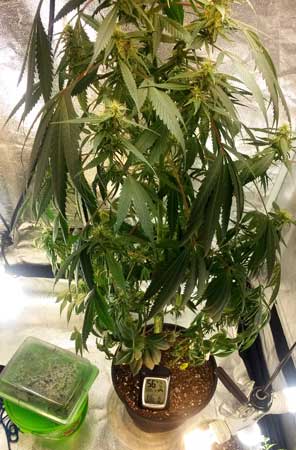by Nebula Haze
Have you ever noticed your cannabis plants growing slowly, but you can’t figure out why? If so, ask yourself, do the plant’s roots have enough room to grow? Do roots have access to oxygen?
How can I tell if my marijuana plant is rootbound?
“Rootbound” is a term for a common problem that affects many cannabis growers, especially those who grow in small hard-sided pots. How does it happen? When a cannabis plant spends too long in the same container, its roots become rootbound, which means the roots fill up all the space inside the pot and start wrapping around themselves. This restricts root growth and causes other problems like yellowing, droopiness, stunted growth, nutrient deficiencies, and reduced yields.
Rootbound cannabis plants start running into all kinds of problems if you don’t transplant them into a bigger pot.
Another symptom of a rootbound plant is when you see an excessive amount of roots trying to come out the bottom. The roots are desperately looking for room to expand.
Look how rootbound the poor plant was! When roots start growing on top of themselves like this, the plant simply can’t absorb nutrients or water properly. As a result you see droopiness and nutrient deficiencies.
Rootbound cannabis plants start experiencing serious problems that affect their health and yields. Their growth starts to slow down and you may notice leaf discoloration, drooping leaves, or deficiencies in nutrients like nitrogen, since the roots are unable to absorb enough. Rootbound plants also become more prone to pests, mold, and diseases due to their weakened state.
The best way to prevent ever dealing with rootbound plants is to use air pots or fabric pots. Essentially, any containers that let air in from the sides. Air will kill these outside roots (known as “air pruning”) and prevent cannabis plants from becoming rootbound even in a small container.
Learn more about using air pots or fabric pots to prevent cannabis from getting rootbound. (Highly recommended!)
Use fabric pots or air pots and cannabis plants will almost never get rootbound.
When plant roots get constricted, the plant stops growing as well as it could have. Soon plants start getting sick with nutrient deficiencies and droopiness, even if you’re giving nutrients and watering them perfectly. “Rootbound” is most common with hard-sided pots like this, especially small pots. Fabric pots that let air in from the side help prevent roots from encircling and choking the plant.
Note: In order to keep “mother” plants small, some growers keep them in tiny pots under low light conditions on purpose. This is using the rootbound state to keep the plant from growing. Learn more about bonsai moms here.
It can be hard to know exactly when to transplant your cannabis plants into a new container due to being rootbound because you typically can’t actually see the roots. This rootbound cannabis guide and tutorial will share some pictures and scenarios where you might consider transplanting your plants.
A rootbound cannabis plant has roots that encircle the pot. This slowly chokes the plant roots until the plant dies, unless you transplant it.
Signs your cannabis plant is rootbound
- Soil is drying out too quickly – When your container is drying out only a day or two after each watering it means your plant is drinking fast and may need more water than your current container can hold
- Plant is getting root or nutrient problems – A cannabis plant can start showing root or nutrient problems when it’s kept in a too-small container or if it’s become root-bound. These root problems can cause the plant to become droopy, or show unexpected leaf symptoms or deficiencies (such as spots or yellowing leaves). Whenever literally everything else is right but you’re still experiencing these problems, it may be a sign you need to transplant.
- Plant has grown a lot or been in the same container for months. If you’re keeping a mother plant for months, or if a plant has doubled in size in the same container, those are signs you may need to transplant to prevent your plant from getting rootbound.
- Plant is tipping over from its own weight. When your cannabis plant is much wider and taller than its container, it’s easy to tip over and therefore should be transplanted into a bigger pot that can hold it steady.
- Plant is just plain too big for the container (pics below) – There are some pictures below to give you an idea of what a plant looks like that needs to be transplanted. Some plants are just plain too big for the containers they are in.
Now let me give you a few real-life examples you can use to refer to. The following transplanting pictures should help give you an idea of exactly when to transplant your cannabis plants!
These marijuana plants are ready to be transplanted
This cannabis seedling is ready to transplant – you can transplant a cannabis plant from a solo cup once its leaves reach the edges. Don’t wait much longer than this for a seedling in a solo cup!
This next cannabis seedling is huge for a solo cup – it should have been transplanted weeks ago! The strange curling symptoms are a sign that the roots aren’t happy. Once this plant was transplanted it started growing perfectly again.
Sometimes a rootbound cannabis plant shows strange symptoms that almost look like nutrient deficiencies and/or overwatering, when the real problem is it just needs a bigger container!
This next marijuana plant is also way too big for its solo cup. Although it still looks relatively healthy, notice the yellowing bottom leaves with spots and bluish color. If this plant isn’t transplanted to a bigger container, those leaf symptoms will continue moving up the plant and start causing problems. Additionally, most likely this plant would already be much bigger if its roots weren’t being constrained by the solo cup.
That solo cup plant eventually stopped growing and started getting droopier every day. Inside the cup, the plant was completely rootbound. Once it got transplanted into a new pot, this plant exploded in growth.
This marijuana plant isn’t showing symptoms yet, but it’s too big for its pot and should be transplanted before initiating the flowering stage (the sensitive time of life when cannabis plants grow buds).
These cannabis plants are way too big for their containers and they’re starting to show strange leaf symptoms, drooping, and curling because roots aren’t getting what they need
When a cannabis plant is much wider than its pot, it should be moved to a bigger container even if it’s not showing signs of being root-bound. Not only will the plant roots love the extra space, your plant won’t be so easy to tip over!
This cannabis plant was not transplanted before it started flowering. Although it was healthy its whole life, in the middle of the flowering stage it started drooping and showing these symptoms, because the plant was rootbound. Although it’s generally not recommended to transplant a marijuana plant in the flowering stage, that’s what was needed to fix up this plant and get to harvest!
How to Transplant Cannabis
If you notice any signs of rootbound in your plants, don’t panic. Follow these simple steps to transplant your marijuana plant so it grows fast and healthy again.
- Water your cannabis plants 1-2 days before transplanting. This will help the growing medium stay together (since it’s moist), but still slide out easily (since it’s not soaking wet).
- Fill your new pot with potting mix. Don’t fill the pot to the top, instead leave about 2 extra inches (5 cm). That way you can easily water the plant without all the water running off the sides.
- Water this new container of potting mix before you begin the transplant so it’s nice and moist. If you don’t water the new soil first, it can have a hard time absorbing water after the transplant, and your roots won’t like that!
- Dig a hole – Since you will soon be adding a new plant, you want to dig out a hole in the middle that’s about the size of your old container.
- Remove the plant from the old pot – Take your plant, and carefully slide a butter knife inside the container all around the edges to help separate the rootball from the sides of the pot. Avoid grabbing the plant directly by the stem. Try to grab the whole top with a flat hand, and turn the container upside down so you can gently pat the rootball out and catch it with your flat hand. You may have to gently pull the plant out of the container, but go slowly and be gentle.
- Plant the rootball directly into the new container, placing it in the hole you dug out earlier. You may need to add more soil on top to ensure a nice flat surface.
- Gently pat down around the roots, to help press everything together slightly, then water your plant immediately.
- Water thoroughly – Give water after transplanting to help all the grow medium settle together so roots adjust to their new home. If you do it right, it won’t stress your plants at all! Read a few more tips here.
Read the complete transplanting guide!
How to Prevent Rootbound in the first place
Here are some tips to prevent cannabis plants from getting rootbound.
- Avoid hard-sided containers (most important) – Instead, use air pots or fabric pots, which let air in from the sides. This is the best defense against rootbound. Exposure to air not only prevents rootbound from happening, but also causes cannabis plants to grow faster and yield better. Learn more about air pots vs fabric pots vs regular pots.
- Get the right size container – A cannabis plant typically needs at least a 2-3 gallon pot to flower successfully without running into a lot of problems. I generally use 3-gallon fabric pots when growing a lot of smaller plants, or 5-gallon fabric pots if I’m growing just a few big plants. The beauty with using fabric pots is if your plants get too big you just need to water them more often. But they won’t get rootbound with encircling roots. Learn more about plant containers.
- Transplant plants that stay in the same pot for long periods – For example if you’re keeping mother plants for months at a time, it’s helpful to transplant them every 3-4 months. Learn more about keeping bonsai mother plants in small pots.
More on Cannabis Life Stages…
- Germination
- Vegetative Stage (Getting Bigger)
- Flowering Stage (Making Buds)
- Harvest
Problems & Symptoms
- Cannabis Problems Guide
- Diagnose Your Sick Plant
- Bugs & Other Cannabis Pests
- How to Prevent Nutrient Deficiencies
- 7-Step Remedy That Fixes 99% of Grow Problems

